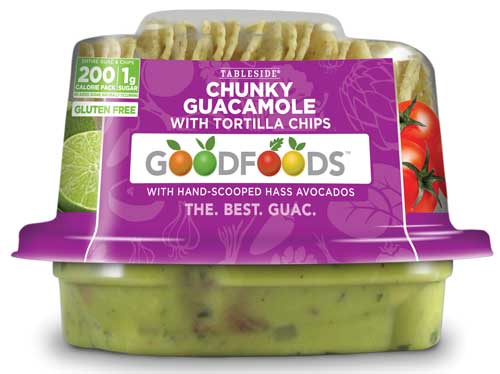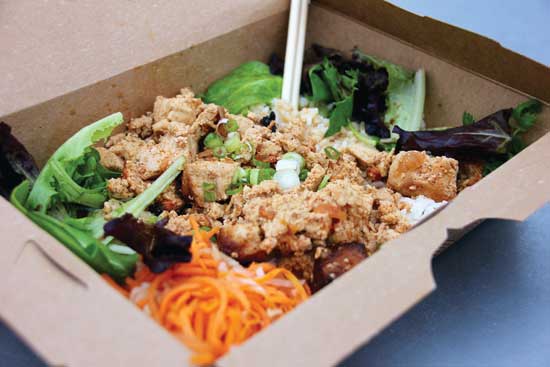Foodservice Craves Packaging Innovation
PACKAGING
The once firm separation between grocery and foodservice venues is deteriorating. As a result, foodservice packaging is expanding rapidly. It is now seen in grocery stores, “grocerants” (restaurants based in grocery stores), micromarkets, vending, C-stores, takeout restaurants, and quick-service restaurants (QSRs). Package design is flexing fast to meet increased demand and venue needs. Still, more innovative package research and design are needed to increase shelf life, provide tamper evidence, and address environmental opportunities while meeting operator needs.
Package Design for Foodservice Operators
Packaging that reduces labor and space, eliminates food safety risks, and extends shelf life is a benefit for foodservice operators. Packaging that saves labor and space eliminates the need for gluing/taping operations, reduces double handling of packaging and food, facilitates minimal handling of food, and allows ease of personalization. For example, the Cariol carton by Huhtamaki, Espoo, Finland (huhtamaki.com), eliminates glue and recontamination while reducing storage space via a sealed pop-up paperboard carton. Rigid recycled or crystalline polyethylene terephthalate (rPET or cPET) containers by Sonoco, Hartsville, S.C. (sonoco.com), with multiple compartments for dips and sauces provide separation from food items, the ability to fill compartments before rush times, and the ability to add consumer selections as they are ordered. There are fewer food safety risks when packaging design is optimal for food preparation while foodservice workers are wearing gloves or while consumers are dispensing products such as sauces and condiments to customize their food. For example, YesPack, the nylon and polyethylene–based structure made by Coveris, Spalding, United Kingdom (coveris.com), and used for Kraft salad dressings presents minimal cross-contamination risk. Similarly, the Ghirardelli pouch-and-pump dispensing system has a pouch within a reusable bottle for ease of dispensing and little contamination while consumers dispense coffee cream. Increasing shelf life reduces food safety risk as well. Innovations such as the modified atmosphere carton by RAP, London (rapuk.com), has clear hermetically sealed windows, which allow for lower microbial growth and increased shelf life. Designing foodservice packaging to save labor and decrease food safety risks is continually evolving. Lynn Dyer, president of the Foodservice Packaging Institute (FPI), directs research and provides resources for the entire foodservice packaging supply chain. “While much progress on labor-saving packaging and packaging that decreases food safety risks has been made, more progress can be made,” she says.
Package Design for Consumers
In response to increased consumer demand for prepared foods, the design of foodservice packaging is changing. In the prepared foods category, packaging is seen as having the power to fuel further growth, raise consumer satisfaction, and establish new venues. In Dyer’s 19 years with FPI, she has seen many changes in foodservice packaging. “We measure the pulse of the industry with blogs, research, and numerous resources. Now, we are seeing major shifts in what is required in terms of packaging to meet consumer needs. One new focus is on the role of packaging in providing enhanced product integrity. When foods and beverages are handed across a counter and consumed immediately, the demands on that package are less, but if foods and beverages are delivered/transported and then consumed 30 minutes after leaving the food operator, package demands expand,” Dyer explains. Consumers now purchase ready-to-eat and heat-and-eat food from grocerants, micromarkets, vending operations, C-stores, takeout restaurants, and QSRs. Grocerant sections within Dollar General Express, Trader Joe’s, Whole Foods Market, and others are perceived as destinations for distinctive food offerings in packaging that adds value. Foodservice packaging for prepared foods meets the need of people confronted with work and economic shrinkage, and social and family demands. Consumers’ visits to C-stores to purchase prepared meals increased 15% between 2010 and 2016 to 4.9 billion visits. New venues providing prepared foods have increased the time between purchase and consumption. To accommodate delayed consumption, packaging with compartments, tamper-evident features, higher resistance to grease/oil, and elegance meet consumer needs better than packaging immediately unwrapped and consumed at a QSR.
 Compartments in packages separate foods so that textures, flavors, and products remain distinct for a longer period of time. Meal kits, offering picnic-like compartments for easy on-the-go eating are increasingly popular in foodservice packaging. Examples include the McDonald’s Fruit ‘N Yogurt Parfait with Granola in a PET cup with a cup containing high-moisture yogurt and a dome containing low-moisture granola. Good Foods’ Grab & Go packs separate low-moisture chips and high-moisture high-pressure processed guacamole dip using PET cups and foil lidding. Whole Foods Market’s foodservice trays that allow consumers to take home different prepared food selections are multi-compartmental as well. Tamper-evident foodservice packaging has become a consumer expectation at C-stores, supermarkets, and delis, and for delivered food. Tamper-evident features are simply accomplished with paper deli stickers across the top and base of packages that tear if the packages are opened. Companies are increasingly integrating tamper-evident features into package designs. For example, RoundWare and Safe-T-Fresh by Inline Plastics, Shelton, Conn. (inlineplastics.com), and SafeSeal bowls by Dart Container, Mason, Mich. (dartcontainer.com), provide tamper evidence with easy open and close features.
Compartments in packages separate foods so that textures, flavors, and products remain distinct for a longer period of time. Meal kits, offering picnic-like compartments for easy on-the-go eating are increasingly popular in foodservice packaging. Examples include the McDonald’s Fruit ‘N Yogurt Parfait with Granola in a PET cup with a cup containing high-moisture yogurt and a dome containing low-moisture granola. Good Foods’ Grab & Go packs separate low-moisture chips and high-moisture high-pressure processed guacamole dip using PET cups and foil lidding. Whole Foods Market’s foodservice trays that allow consumers to take home different prepared food selections are multi-compartmental as well. Tamper-evident foodservice packaging has become a consumer expectation at C-stores, supermarkets, and delis, and for delivered food. Tamper-evident features are simply accomplished with paper deli stickers across the top and base of packages that tear if the packages are opened. Companies are increasingly integrating tamper-evident features into package designs. For example, RoundWare and Safe-T-Fresh by Inline Plastics, Shelton, Conn. (inlineplastics.com), and SafeSeal bowls by Dart Container, Mason, Mich. (dartcontainer.com), provide tamper evidence with easy open and close features.
From a functional perspective, the length of time in a package requires improved barrier properties. For example, increased oil and grease resistance is needed for many foodservice packages if food remains in the package for 30 minutes or more. Each food with specific temperature and oil/grease content is evaluated after using standard tests to screen options. Solutions such as GlazeGuard by Versoco, Memphis, Tenn. (versoco.com); Enshield by WestRock, Norcross, Ga. (westrock.com); Zanbarrier OGR from Zanders, Bergisch Gladbach, Germany (zanders.com), offer exceptional resistance to oil and grease. Recyclable barriers resistant to oil and grease are a growing area of research because high resistance often requires the use of coatings that may make paperboard and paper nonrecyclable or contain perfluorinated compounds, which are still in use despite government bans. Bio & Chic, New York (bioandchic.com), and Korin, New York (korin.com), distribute a variety of elegant foodservice packaging solutions such as reusable, disposable and stackable bento boxes. Stackability for ease of transport is becoming more critical as it facilitates product integrity during delivery via entities such as Grubhub. Addressing shortcomings in packaging design will better meet the needs of foodservice consumers.
 Design for the Environment
Design for the Environment
Consumer preference for foodservice packaging that is readily recyclable or compostable is increasing; this is steering the packaging industry toward more sustainable materials. The reality is that, although highly visible, foodservice packaging makes up only about 1.4% of the U.S. municipal solid-waste stream. Closed venues are a testing ground for composting and recycling for foodservice and non-foodservice packaging. Closed venues offer behavior modeling by essentially demonstrating to consumers what foodservice packaging can be recycled and composted. Examples of closed venues are airports and stadiums where consumers have little choice on foodservice packaging. In the United States, 95% of airports have recycling and 30% have composting available. At Ohio State University’s stadium, which has ranked number one in zero waste initiatives in the Big Ten Conference for the past four years, 95% of waste is recycled or composted. When recycling and composting behavior is modeled with foodservice packaging at closed venues, this helps guide behavior in handling foodservice packaging elsewhere. Dyer notes, “Seventy percent of packaging leaves the QSR. So while recycling and composting onsite at QSRs can be addressed, municipal recycling and composting need attention as well and consumers need direction on proper disposal. A recent FPI study revealed that consumers look first to the package for directions on disposal.” Directions on the package are critical. This is in alignment with the GreenBlue label instructions on packaging: “How2Recycle” and “How2Compost.”
The consumer appeal of eco-friendly packaging is a major driver of compostable and recyclable polymers. The “How2Compost” label is based on the ASTM D6400 (as opposed to the EU EN13432) standard, requiring degradation in 60 days in industrial composting facilities. When compost and recycling sites and pickup locations are prevalent, composting and recycling are efficient, and foodservice packaging connects with the rest of packaging disposal. Access to composting is not consistent worldwide. If consumers have limited access to composting, compostable packaging for foodservice packaging is ineffective.
Packaging solutions related to recycling focus on enabling recycling and use of recycled content. Paper Cup Recovery and Recycling Group and the Foodservice Packaging Association are focused on reducing the plastic content in cup liners to enable recycling of foodservice cups. However, despite much acclaim, current options are not conducive to standard recycling streams. Communities differ in what is compatible with recycling streams so much so that Prêt à Manger, for example, screens packaging to be compatible with the recycling streams in the communities it serves. Use of Forest Stewardship Council–certified and recycled content is on the rise, and in the European Union, 100% of all fiber-based McDonald’s packaging is from certified or recycled sources. Consumer interest in environmental issues and material-focused initiatives continue to guide foodservice package development.
 Claire Koelsch Sand, PhD, Contributing Editor
Claire Koelsch Sand, PhD, Contributing Editor
President, Packaging Technology and Research
Adjunct Professor, Michigan State Univ.
[email protected]
